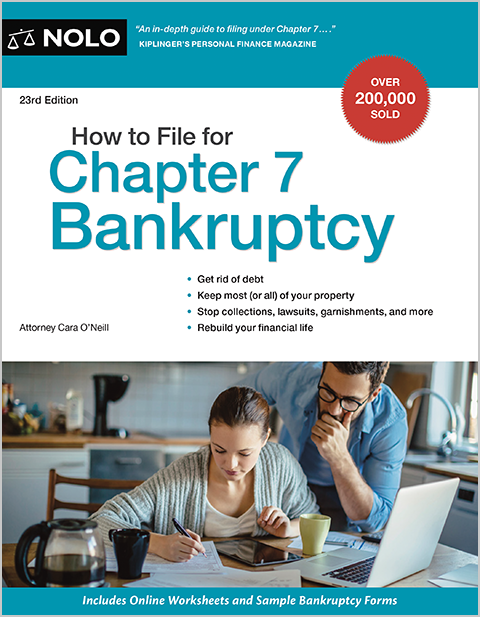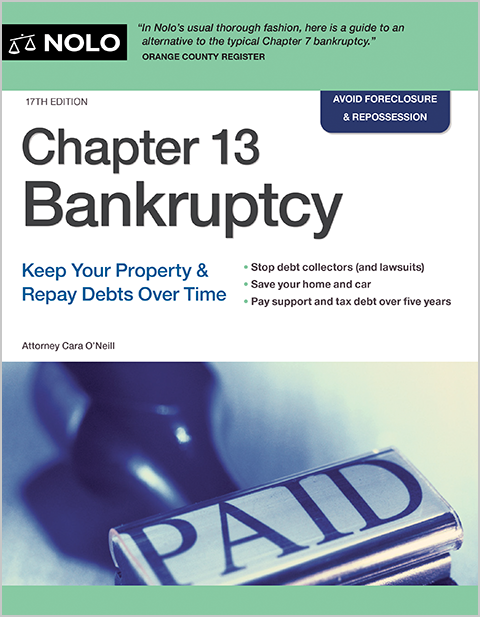Some filers can "discharge" or wipe out tax debts in Chapter 13 bankruptcy but most pay it through the Chapter 13 repayment plan. Whether discharged or paid, Chapter 13 bankruptcy clears tax debt by the end of the plan.
Many types of taxes can be included in Chapter 13—IRS debt being the most common. Depending on the age, some IRS debt can be discharged in Chapter 13, and filers can repay other IRS debt in Chapter 13 through the monthly payment plan.
It's also possible to get property tax relief in bankruptcy. Learn how to clear IRS tax debt and property taxes in Chapter 13 by catching up on what you owe over time.
Chapter 13 Bankruptcy Can Clear Tax Debt
Chapter 13 bankruptcy can be an excellent tool when you fall behind on your taxes because it allows you to discharge (wipe out) old income tax debt. If you have tax debt or property tax you can't discharge, you'll pay it off in Chapter 13 bankruptcy, instead.
So why would you file for bankruptcy instead of agreeing to a payment plan with the IRS or another taxing authority? The Chapter 13 payment plan might give you a more favorable repayment schedule—meaning a lower monthly payment—than you would receive otherwise.
However, you might actually pay more in bankruptcy than you would otherwise. When comparing how much you'll pay, it's essential to compute interest and the Chapter 13 trustee's fee. The trustee's fee alone can be as high as 10%.
Taxes in Chapter 13 Bankruptcy
Delinquent taxes must meet qualification requirements before being discharged in a Chapter 13 case. Any portion failing to meet the requirements must be paid in full over the course of a three- to five-year payment plan. Here are examples of what will happen to different types of taxes in a Chapter 13 bankruptcy.
Income Taxes
If the tax is on income or gross receipts, you'll start by determining whether it's a priority or nonpriority debt. Priority tax must be paid in full in the Chapter 13 plan. By contrast, nonpriority tax gets lumped with other unsecured debt (like credit cards and medical bills).
All nonpriority unsecured creditors must share your "discretionary income," or the amount remaining after deducting allowed living expenses and payments (such as your house and car payment). Because you pay only your discretionary income to this group, you likely won't have to pay all your nonpriority tax debt.
To learn more about how your plan payment is determined, visit Your Obligations Under a Chapter 13 Bankruptcy Plan.
What Are Priority and Nonpriority Taxes?
Your taxes are nonpriority if they meet the following criteria:
- The taxes are on income or gross receipts.
- The income taxes were due at least three years (including valid extensions) before you filed the bankruptcy. For instance, your tax return for 2012 was due on October 15, 2013, after you requested an extension. That tax would not be considered a priority tax in a bankruptcy case filed on October 16, 2016, or later. If your return were due on April 15, 2014, the taxes would be priority taxes in any case filed before April 16, 2017.
- You filed your tax return at least two years before you filed the bankruptcy case. If you did not file a timely return or if the IRS filed a substitute return for you, some bankruptcy courts have held that those taxes remain priority forever.
- The taxing authority assessed the tax (entered on the books as a tax liability) at least 240 days before you filed your bankruptcy case. This period can be lengthened in certain cases.
- You didn't commit fraud or willfully evade paying your taxes for the tax year in question.
If you don't meet the following, your tax will be considered a priority tax that must be paid in full in your Chapter 13 plan.
Other Priority Taxes
Recent income taxes aren't the only types of priority tax debt. Other taxes that must be paid in full through the Chapter 13 plan include:
- trust fund taxes (FICA, Medicare, and income taxes that you withhold from an employee's paycheck)
- sales tax collected from customers
- certain employment taxes, excise taxes, and custom duties
- tax penalties for nondischargeable taxes, and
- erroneous tax refunds or credits relating to nondischargeable taxes.
A bankruptcy attorney can tell you the priority status of your tax, or, you can call the taxing agency and ask.
Secured Tax Debts
If your tax debt is a secured liability—meaning that the taxing agency took steps to gain an ownership interest in your property—then you won't be able to discharge the obligation. Here are two examples:
- Tax liens. If you owe a large amount of taxes, the taxing authority might file a lien to secure payment. In a Chapter 13 case, you'll have to pay the entire amount of the tax lien over the course of the plan.
- Recent property taxes. For the most part, property taxes are secured by tax liens against the property, so any balance owed must be paid in full in the Chapter 13 plan. If there is no tax lien, it's still a priority claim if it was incurred within one year before the filing of the bankruptcy case. Otherwise, it's a nonpriority claim.
To learn about your other options for dealing with tax debt, see Back Taxes & Tax Debt.
Can IRS Tax Debt Be Discharged in Chapter 7 Bankruptcy?
Yes, in some cases. In most instances, the tax must be over three years old and meet other requirements. If your IRS tax debt qualifies for a discharge, it will be erased with other qualifying debt.
Because the requirements for discharging tax debt in Chapter 7 differ depending on the state, it's often simpler to call the IRS and ask whether you can discharge what you owe. However, you'll want to verify with a local bankruptcy lawyer before proceeding.
You can learn more about discharging tax obligations in bankruptcy by reading Tax Debts in Chapter 7 Bankruptcy.
Need More Bankruptcy Help?
Did you know Nolo has made the law accessible for over fifty years? It's true, and we want to ensure you find what you need. Below, you'll find more articles explaining how bankruptcy works. And don't forget that our bankruptcy homepage is the best place to start if you have other questions!
|
Our Editor's Picks for You |
|
|
More Like This |
Will Bankruptcy Stop the IRS from Collecting Tax Debt? |
|
Consider Before Filing Bankruptcy |
Preparing for Bankruptcy: What to Do With Bank Accounts, Automatic Payments, and Utility Deposits Can I Keep My Tax Refund in Chapter 7 Bankruptcy? |
|
Helpful Bankruptcy Sites |
We wholeheartedly encourage research and learning, but online articles can't address all bankruptcy issues or the facts of your case. The best way to protect your assets in bankruptcy is by hiring a local bankruptcy lawyer.
|
|

